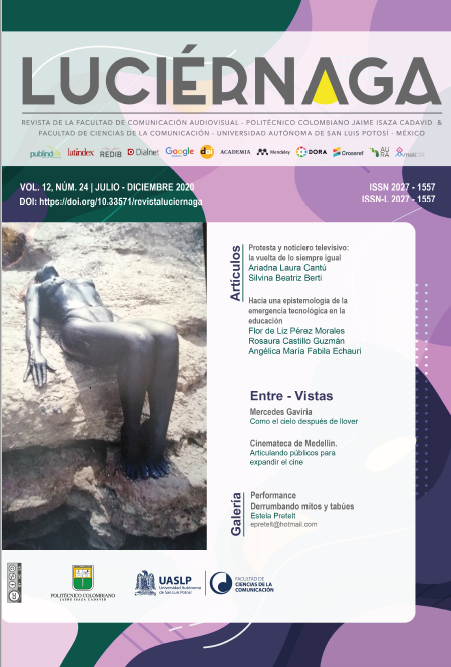The construction of social protests in television news
DOI:
https://doi.org/10.33571/revistaluciernaga.v12n24a1Keywords:
Social protest, newscast, televisionAbstract
This article focuses on the way in which a television news program (Telediario) from the city of Río Cuarto, Córdoba, Argentina, constructs the news about social protest. The quantitative analysis of this type of information makes it possible to account for the most obvious and evident presences and absences of the "reality" shown on the screen. The comparative results of the content analysis carried out from three samples obtained during three different years (2013/2016 and 2019) are presented. This type of news is initially situated in the global context of the television newscast under study. From there on the way in which Telediario presents the dimensions of the protest: the actors (plaintiffs and defendants), their voices, their motive and the methods used is described. Based on this general account, we proceed with a more detailed analysis of these dimensions, of some significant interrelationships that occur between them and of the meanings that emerge from there. It is concluded that the news program tends to construct the protest in a fragmented way, as isolated units, in a decontextualized manner and outside the historical processes in which they occur.
Article Metrics
Abstract: 403 PDF (Español (España)): 227 HTML (Español (España)): 69PlumX metrics
References
Berti, S. y A. Cantú (2011). (Lo que las voces dicen de) las voces de la protesta televisiva. En Revista A Contra Corriente. Vol. 9, Nº 1. Department of Foreign Languages and Literature – North Carolina State University, USA. 2011. Pp. 38-68. ISSN 1548-7083. http:tool.chass.ncsu.edu/open_journal/index.php/acontracorriente/issue/view/16/ShowToc
Cantú, A. y S. Berti (2010) La protesta social: del noticiero a las audiencias. En Perspectivas de la Comunicación. Vol. 3, Nº 2. Universidad de la Frontera. Temuco, Chile. Pp. 64-83. ISSN 0718-4867. http:www.perspectivasdelacomunicacion.cl/revista_2_2010.html
Cantú, A. L. (2015). Nuevos espacios públicos: el consumo de noticias locales como lugar de encuentro. Luciérnaga Comunicación, 5(9), 69-77. Recuperado a partir de https://revistas.elpoli.edu.co/index.php/luc/article/view/302
Condit, C. (1989) Los límites retóricos de la polisemia. En: Critical Studies in Mass Communication. Volume 6, Number 2 - June 1989. Traducción Silvina Berti, Departamento de Ciencias de la Comunicación – UNRC.
Festinger, L. y D. Katz (1972) Los métodos de investigación en las ciencias sociales. Paidós, Bs. As.
Fiske, J (1998) Culture, Ideology, Interpellation. En Rivkin, J. and M. Ryan -edts.- (2004) Literary Theory - An Anthology. Blackwell Publishing Ltd Library of Congress Cataloging-in-Publication Data - http://www.blackwellpublishing.com
González Requena, J. (1992). El discurso televisivo, espectáculo de la posmodernidad. Madrid: Cátedra.
Hall, S. (1992) Raza, Cultura y Comunicación. En Rethinking Marxism, Vol 5, Number 1. Spring. Traducción Silvina Berti, Departamento de Ciencias de la Comunicación – UNRC.
Lozano, J. C. (1994) Hacia la reconsideración del análisis de contenido en la investigación de los mensajes comunicacionales. En Cervantes Barba, C, y E. Sánchez Ruiz, Investigar la comunicación: propuestas iberoamericanas. Universidad de Guadalajara, México.
Morley, D. (1996) Interpretar la televisión: la audiencia de Nationwide. En Televisión, audiencias y estudios culturales. Amorrortu: Buenos Aires
Rusconi, C. (2009) El noticiero televisivo como nuevo espacio público. Tesis de Maestría en Comunicación y Cultura contemporánea, CEA-UNC. Córdoba. Inédita.
Rusconi, C, M. Bosco y M. Milani (2017) Estudio de audiencias. Río Cuarto, diciembre 2016. Cuadernos de Temas y Problemas de Comunicación Nº 9, Centro de Investigación en Comunicación – Dpto. de Ciencias de la Comunicación, FCH, UNRC. Río Cuarto.
Schuster,F. (2005) Las protestas sociales y el estudio de la acción colectiva en Schuster, Federico et al. (comp) Tomar la palabra. Estudios sobre protesta social y acción colectiva en la Argentina contemporánea. Buenos Aires: Prometeo
Scribano, A. (2005) Itinerarios de la protesta y del conflicto social. Villa María-Córdoba: CEA
Scribano, A. y F. Schuster (2001) Protesta social en la Argentina de 2001: entre la normalidad y la ruptura, en Revista del Observatorio Social de América Latina (OSAL). La protesta social en Argentina, Año II, N°5, CLACSO. Recuperado el 26/08/10 de http://www.accioncolectiva.com.ar/documentos/ascribano2001b.pdf
Svampa, M. (2002) Las dimensiones de las nuevas protestas sociales. En Revista El Rodaballo, núm. 14. (invierno, 2002). Recuperado el 10/08/2010 de www.maristellasvampa.net/publicaciones-ensayos.shtlm
Published
How to Cite
Issue
Section
License
Copyright (c) 2020 Silvina Beatriz Berti, Ariadna Laura Cantú

This work is licensed under a Creative Commons Attribution-NonCommercial-ShareAlike 4.0 International License.
Aquellos autores/as que tengan publicaciones con esta revista, aceptan los términos siguientes:- Los autores/as conservarán sus derechos de autor y garantizarán a la revista el derecho de primera publicación de su obra, el cuál estará simultáneamente sujeto a una licencia de Creative Commons Atribución – No comercial – Compartir igual
que permite a terceros compartir la obra siempre que se indique su autor y su primera publicación en esta revista. - Los autores/as podrán adoptar otros acuerdos de licencia no exclusiva de distribución de la versión de la obra publicada (p. ej.: depositarla en un archivo telemático institucional o publicarla en un volumen monográfico) siempre que se indique la publicación inicial en esta revista.
- Se permite y recomienda a los autores/as difundir su obra a través de Internet (p. ej.: en archivos telemáticos institucionales o en su página web) antes y durante el proceso de envío, lo cual puede producir intercambios interesantes y aumentar las citas de la obra publicada. (Véase El efecto del acceso abierto)
- Luciérnaga-Comunicación no cobra tasas o cargos a Autores o colaradores por la recepción, revisión o publicación de artículos (APC -Article Processing Charges/ publication fee).

















